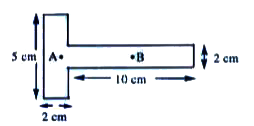Two particles having masses m and 2m are travelling along x-axis on a smooth surface with velocities u1 and u2, collide. If their velocities after collision are v1 and v2, then the ratio of velocities of their centre of mass before ans impact is Solution in Telugu
2:1
2:3
1:1
1:2
The correct Answer is:C
Step by step video, text & image solution for Two particles having masses m and 2m are travelling along x-axis on a smooth surface with velocities u_(1) and u_(2), collide. If their velocities after collision are v_(1) and v_(2), then the ratio of velocities of their centre of mass before ans impact is by Physics experts to help you in doubts & scoring excellent marks in Class 11 exams.
Topper's Solved these Questions
- BOOK - AAKASH SERIESCHAPTER - SYSTEM OF PARTICLES AND ROTATIONAL MOTIONEXERCISE - EXERCISE - 361videos
SYSTEM OF PARTICLES AND ROTATIONAL MOTION
- BOOK - AAKASH SERIESCHAPTER - SYSTEM OF PARTICLES AND ROTATIONAL MOTIONEXERCISE - EXERCISE-I (Centre of Mass)40videos
SYSTEM OF PARTICLES AND ROTATIONAL MOTION
- BOOK - AAKASH SERIESCHAPTER - SYSTEM OF PARTICLES AND ROTATIONAL MOTIONEXERCISE - EXERCISE - 1B51videos
SYSTEM OF PARTICLES AND ROTATIONAL MOTION
- BOOK - AAKASH SERIESCHAPTER - SURFACE TENSIONEXERCISE - ADDITIONAL PRACTICE EXERCISE (PRACTICE SHEET (ADVANCED) INTEGER TYPE QUESTIONS )8videos
SURFACE TENSION
- BOOK - AAKASH SERIESCHAPTER - THERMAL PROPERTIES OF MATTEREXERCISE - ADDITIONAL PRACTICE EXERCISE (LEVEL - II) PRACTICE SHEET (ADVANCED) Integer/Subjective Type Questions2videos
THERMAL PROPERTIES OF MATTER
Similar Questions
The C.M of a uniform card board cut in .T. shape as shown in figure is
 00:53View Solution
00:53View SolutionThree identical spheres each of radius R are placed touching each other on a horizontal table. The centre of mass of the system is located
03:07View Solution(A) : Position of centre of mass of a body (w.r.t body frame) is independent of co-ordinate system.
(R ) : Internal forces do not effect the motion of centre of mass.02:13View SolutionIf the work done in blowing a soap bubble of volume 'V' is W, then the work done in blowing a soap bubble of volume '2V' is
View SolutionA constant pressure gas thermometer has a volume of 200cc, 273.2cc and 525 .1cc at 0°C, 100°C and boiling point of sulphur respectively. The resistance possessed by a platinum wire at the same temperatures as above are 2.000Ω,2.778Ωand5.280Ω respectively. Estimate the boiling point of sulphur on the basis of the two sets of observations.
02:39View SolutionIf u1 and u2 be the initial velocity and v1 and v2 be the final velocities of the colliding partical then we define coefficient of restitution e as:
e=v1−v2u1−u2
For perfectly inelastic collision 'e' is02:16View SolutionTwo particles of masses m_(1),m_(2) move with initial velocities u_(1) and u_(2) . On collision, one of the particles get excited to higher level, after absording enegry. If final velocities of particles be v_(1) and v_(2) then we must have
01:55View SolutionA particle of mass m moving with velocity u1 collide elastically with another particle of same mass moving with velocity u2 in the same direction. After collision their speeds are v1 and v2 respectively then
(A) u1+v1=v2+u2, (B) u1−v1=v2+u2View SolutionA ball of mass m moving with a speed u_(1) collides elasticity with another identical ball moving with velocity u_(2) . (a) Find the velocities of the balls after collision if the impact is direct. (b) Find the angle between velocities after collision if they collide obliquely and u_(2)=0
View SolutionTwo particles of mass mA and mB and their velocities are VA and VB respectively collides. After collision they interchanges their velocities, then ratio of mAmB is
02:29View Solutionदो कणों के द्रव्यमान क्रमशः m1 तथा m2 हैं, इनके प्रारम्भिक वेग क्रमशः u1 तथा u2 हैं। टक्कर के पश्चात एक कण E ऊर्जा अवशोषित कर उच्चतर स्तर तक उत्तेजित हो जाता है। यदि कणों के अंतिम वेग क्रमशः v1 तथा v2 हों, तो
View SolutionIf u1,u2 and v1,v2 are the initial and final velocities of two particles before and after collision respectively, then v2−v1u1−u2 is called ___________.
View SolutionTwo bodies of masses m_(1) and m_(2) moving on the same direction with velocities u_(1) and u_(2) collide. The velocities after collision are V_(1) and V_(2) . If each sphere loses the same amount of kinetic energy, then
02:10View SolutionTwo particles having masses m and 2m are travelling along X-axis on a smooth surface with velocities u1andu2 collide. If their velocities after collision are v1andv2 then the ratio of velocities of their centre of mass before and after impact is
03:51View SolutionTwo particle of masses m1.m2 moves with initial velocities u1andu2 . On collision one of the particles get excited to higher level after absorbing energy ε . If final velocities of particles be v1andv2 then we must have :
02:49View Solution

